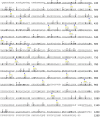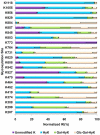LC-MS/MS identification of the O-glycosylation and hydroxylation of amino acid residues of collagen α-1 (II) chain from bovine cartilage
- PMID: 23879958
- PMCID: PMC4866811
- DOI: 10.1021/pr400101t
LC-MS/MS identification of the O-glycosylation and hydroxylation of amino acid residues of collagen α-1 (II) chain from bovine cartilage
Abstract
O-Glycosylation of collagen is a unique type of posttranslational modifications (PTMs) involving the attachment of galactose (Gal) or glucose-galactose (Glc-Gal) moieties to hydroxylysine (HyK). Also, hydroxyproline (HyP) result from the posttranslational hydroxylation of some proline residues in collagen. Here, LC-MS/MS was effectively employed to identify 23 O-glycosylation sites and a large number of HyP residues associated with bovine type II collagen α-1 chain (CO2A1). The modifications of the 23 O-glycosylation sites varied qualitatively and quantitatively. Both Gal and Glc-Gal moieties occupied 22 of the identified glycosylation sites, while K773 was observed as unmodified. A large number of HyP residues at Yaa positions of Gly-Xaa-Yaa motif were detected. HyP residues at Xaa positions of Gly-HyP-HyP, Gly-HyP-Ala, and Gly-HyP-Val motifs were also observed. Notably, HyP residue of Gly-HyP-Gln motif was detected, which has not been previously reported. Moreover, the deamidation of 8 Asn residues was identified, of which 2 Asp residues were observed at different retention times because of isomerization (Asp vs isoAsp). Partial macroheterogeneities of some CO2A1 glycosylation sites were revealed by LC-MS/MS analysis. ETD experiments revealed partial macroheterogeneities associated with K299-K308, K452-K464, K464-K470, and K857-K884 glycosylation sites. Semiquantitative data suggest that the glycosylation of hydroxylysine residues is site-specific.
Figures





Similar articles
-
Quantitative proteomic profiling of extracellular matrix and site-specific collagen post-translational modifications in an in vitro model of lung fibrosis.Matrix Biol Plus. 2019 Apr 13;1:100005. doi: 10.1016/j.mbplus.2019.04.002. eCollection 2019 Feb. Matrix Biol Plus. 2019. PMID: 33543004 Free PMC article.
-
Identification of 4-Hydroxyproline at the Xaa Position in Collagen by Mass Spectrometry.J Proteome Res. 2019 May 3;18(5):2045-2051. doi: 10.1021/acs.jproteome.8b00930. Epub 2019 Apr 12. J Proteome Res. 2019. PMID: 30945869
-
Glycosylation of Type I Collagen.Methods Mol Biol. 2019;1934:127-144. doi: 10.1007/978-1-4939-9055-9_9. Methods Mol Biol. 2019. PMID: 31256377
-
Collagen hydroxylysine glycosylation: non-conventional substrates for atypical glycosyltransferase enzymes.Biochem Soc Trans. 2021 Apr 30;49(2):855-866. doi: 10.1042/BST20200767. Biochem Soc Trans. 2021. PMID: 33704379 Review.
-
Extensin: repetitive motifs, functional sites, post-translational codes, and phylogeny.Plant J. 1994 Feb;5(2):157-72. doi: 10.1046/j.1365-313x.1994.05020157.x. Plant J. 1994. PMID: 8148875 Review.
Cited by
-
Quantitative proteomic profiling of extracellular matrix and site-specific collagen post-translational modifications in an in vitro model of lung fibrosis.Matrix Biol Plus. 2019 Apr 13;1:100005. doi: 10.1016/j.mbplus.2019.04.002. eCollection 2019 Feb. Matrix Biol Plus. 2019. PMID: 33543004 Free PMC article.
-
Glycosylation and cross-linking in bone type I collagen.J Biol Chem. 2014 Aug 15;289(33):22636-22647. doi: 10.1074/jbc.M113.528513. Epub 2014 Jun 23. J Biol Chem. 2014. PMID: 24958722 Free PMC article.
-
Elucidation of a Human Urine Metabolite as a Seryl-Leucine Glycopeptide and as a Biomarker of Effective Anti-Tuberculosis Therapy.ACS Infect Dis. 2019 Mar 8;5(3):353-364. doi: 10.1021/acsinfecdis.8b00241. Epub 2019 Jan 10. ACS Infect Dis. 2019. PMID: 30585483 Free PMC article. Clinical Trial.
-
High-resolution mass spectrometry confirms the presence of a hydroxyproline (Hyp) post-translational modification in the GGGGP linker of an Fc-fusion protein.MAbs. 2017 Jul;9(5):812-819. doi: 10.1080/19420862.2017.1325556. Epub 2017 May 16. MAbs. 2017. PMID: 28506197 Free PMC article.
-
Effects of Glycosylation on the Enzymatic Activity and Mechanisms of Proteases.Int J Mol Sci. 2016 Nov 25;17(12):1969. doi: 10.3390/ijms17121969. Int J Mol Sci. 2016. PMID: 27898009 Free PMC article. Review.
References
-
- Miller EJ, Lunde LG. Isolation and characterization of the cyanogen bromide peptides from the alpha 1(II) chain of bovine and human cartilage collagen. Biochemistry. 1973;12(17):3153–9. - PubMed
-
- Chung E, Miller EJ. Collagen polymorphism: characterization of molecules with the chain composition (alpha 1 (3)03 in human tissues. Science. 1974;183(130):1200–1. - PubMed
-
- Gelse K, Poschl E, Aigner T. Collagens--structure, function, and biosynthesis. Adv Drug Deliv Rev. 2003;55(12):1531–46. - PubMed
Publication types
MeSH terms
Substances
Grants and funding
LinkOut - more resources
Full Text Sources
Other Literature Sources
Miscellaneous

